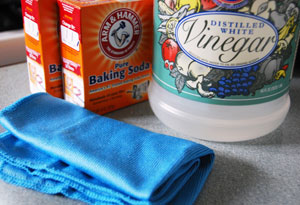Clean and Green

Photo: Jessica Sain-Baird
I grew up in a house where my mom bragged you could eat off the floors. I, at one point, seemed to have inherited those same traits, once demonstrating to a boyfriend that my floors were clean enough to eat off of by licking them. Now, I find dust bunnies that rival the size of real ones and have acquired a pesky habit of holding on to stuff I no longer want or need. I'm determined to do things differently.
Don't get me wrong. I am cluttered, but my place is pretty clean. It's just clean in a different way than what I grew up with and many folks are used to. My parents' house was wiped down with bleach and other harsh chemicals, while mine is cleaned with eco-friendly products.
We've been somewhat indoctrinated to think that the acrid smell of bleach is the smell of "clean," but the chemical found in bleach (sodium hypochlorite) and other household products, including mildew remover and toilet cleaner, can burn our skin, cause a host of respiratory and gastrointestinal problems and may even be fatal.
My father, the most brilliant of scientists, will tell you that what matters are the amount, strength and method of exposure to household chemicals. He's right. Sodium hypochlorite is used to purify our drinking water (which, to me, seems dreadful, and I wonder why we can't just keep our water cleaner to begin with—but that's for another post) and is a mighty powerful disinfectant. But what we must also consider are the toxic cocktails we're whipping up when we mix bleach with, say, an ammonia-based cleaner. That causes the release of chloramines, generates hazardous fumes and is part of the reason the Environmental Protection Agency has found indoor air to be twice as polluted as outdoor air (a stat I have repeatedly recited).
Furthermore, we all have different tolerance levels. My sister is violently allergic to cats and pollen, while I can't even really conceive of what an allergy looks or feels like. The Food and Drug Administration doesn't require companies to divulge the contents of their products or the concentrations with which they are used. This means the most vulnerable among us are exposed to substances that sit on our floors and countertops, cling in our air and wash down our drains and toilets into our water supplies that might be really harmful. Just think about your pets or babies crawling around on floors cleaned with contents you aren't sure of, then sticking their little hands and feet in their mouths.
Don't get me wrong. I am cluttered, but my place is pretty clean. It's just clean in a different way than what I grew up with and many folks are used to. My parents' house was wiped down with bleach and other harsh chemicals, while mine is cleaned with eco-friendly products.
We've been somewhat indoctrinated to think that the acrid smell of bleach is the smell of "clean," but the chemical found in bleach (sodium hypochlorite) and other household products, including mildew remover and toilet cleaner, can burn our skin, cause a host of respiratory and gastrointestinal problems and may even be fatal.
My father, the most brilliant of scientists, will tell you that what matters are the amount, strength and method of exposure to household chemicals. He's right. Sodium hypochlorite is used to purify our drinking water (which, to me, seems dreadful, and I wonder why we can't just keep our water cleaner to begin with—but that's for another post) and is a mighty powerful disinfectant. But what we must also consider are the toxic cocktails we're whipping up when we mix bleach with, say, an ammonia-based cleaner. That causes the release of chloramines, generates hazardous fumes and is part of the reason the Environmental Protection Agency has found indoor air to be twice as polluted as outdoor air (a stat I have repeatedly recited).
Furthermore, we all have different tolerance levels. My sister is violently allergic to cats and pollen, while I can't even really conceive of what an allergy looks or feels like. The Food and Drug Administration doesn't require companies to divulge the contents of their products or the concentrations with which they are used. This means the most vulnerable among us are exposed to substances that sit on our floors and countertops, cling in our air and wash down our drains and toilets into our water supplies that might be really harmful. Just think about your pets or babies crawling around on floors cleaned with contents you aren't sure of, then sticking their little hands and feet in their mouths.



